PHOTO COURTESY OF TEXTRON AVIATION
With more than 2,200 jets produced in the Citation 525 series, you can find one at almost every business airport around the world. The line encompasses the CitationJet CJ, CitationJet CJ1+ and Citation M2 (525), CJ2 and CJ2+ (525A), CJ3 and CJ3+ (525B), and CJ4 (525C).
Our focus here is the Cessna Citation M2, the current-production entry into the series. Since 2013, the airplane has proven to be a dependable and efficient performer for operators, with Textron Aviation celebrating the 250th delivery in June. Thanks to a recent invitation by the company, I traveled to Wichita to fly the latest M2 and provide an updated review.
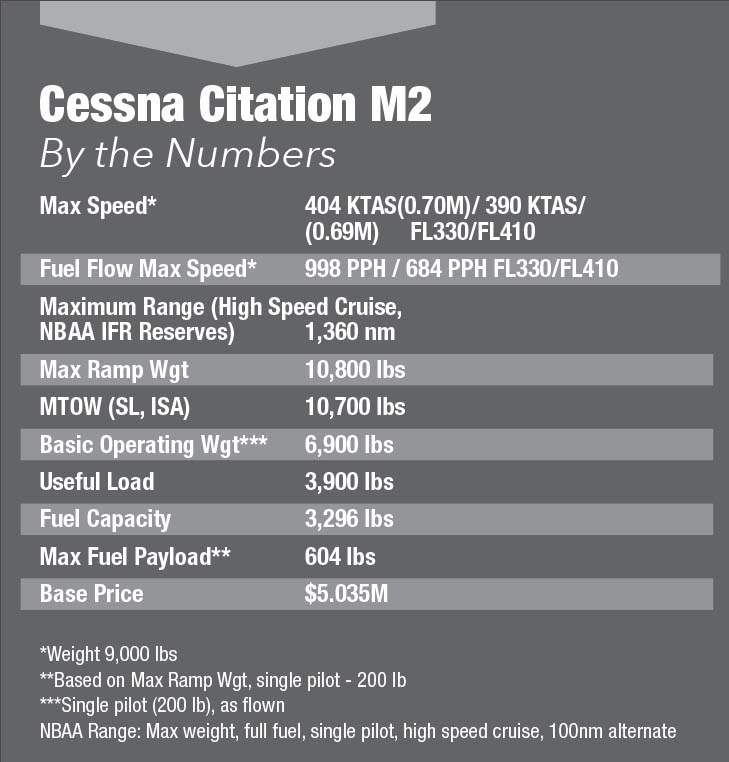
M2 Overview
Following introductions with the Textron Aviation team, we jumped into a technical briefing on the aircraft. Though I have flown and taught in Citation 525 aircraft for several years, it is amazing what you can learn during an in-depth briefing.
The M2 is assembled at Textron Aviation’s Independence, Kansas, facility, which was also the former home of the Citation Mustang. Building on the success of the CJ1+, Textron Aviation reinvented the model with new styling, avionics and powerplant enhancements. While the basic fuselage and systems are nearly identical to previous models in the 525 series, the M2 sports the Garmin G3000 avionics, an improved cockpit, a more comfortable cabin interior and, of course, winglets!
Textron Aviation also worked with Williams International to install the upgraded FJ44-1AP-21 turbofan engine. When compared to the CJ1+, the new variant offers up to 15 percent additional cruise thrust and a 5 percent improvement when operating at higher density altitude airports. One of the benefits of the improved performance is the ability to depart from Aspen, Colorado (KASE) at 24 degrees Celsius (75 degrees Fahrenheit) with a higher MTOW. As an example, if using one of the M2’s I fly and Special Departure Procedures for Runway 33 or Textron’s CESNAV app, it is possible to take off at a weight of 10,700 lbs, payload of 800 lbs, and 3,280 lbs of fuel. I prefer to take off at a lower weight and use less runway, however, this configuration also holds enough fuel to fly 1,335 nm. Very impressive for a light jet.
The M2 offers a number of avionics options, with most owners selecting Synthetic Vision, Surface Watch, Sirius XM Weather and Radio, Flightstream 510 and the upgraded Garmin GWX 80 weather radar with turbulence detection. Other popular options include TCAS II, the advanced TAWS A, and internet capabilities using either Swift Broad Band or the GOGO ATG 3000 systems. With more aircraft operating internationally, the HF, FANS-1/A options now offer expanded capabilities.
With the advent of the M2, CJ3+ and newer Citations, Textron Aviation provides a comprehensive system monitoring capability that continually records the health of a number of aircraft systems. The Central Diagnostics Maintenance System (CDMS) coupled with the Aircraft Recording System (AReS) also has the capability to transmit data via the optional Garmin GSR56 Iridium communicator or Wi-Fi using the Garmin GDL59. The system is so extensive that ground maintenance personnel can interact with the flight crew in flight on potential solutions or be ready to resolve it upon landing.
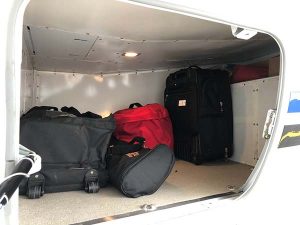
Preflight
For those familiar with the Citation 525 series of jets, the exterior preflight is very similar to other models. One distinction of the M2 is the factory installation of small winglets. Besides adding a nice look on the ramp, they contribute a small amount to the increased range of the M2 versus the previous CJ1+ model. With the ample engine thrust, the M2 is also designed with bleed air for both the windshield anti-ice as well as heating the leading edges of the wings. As with other models in the 525 series, the M2 uses 23 PSI service air to inflate the horizontal stabilizer deice boots.
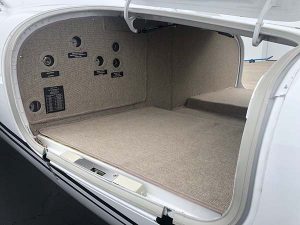
Loading the M2 is easy with the two externally accessible baggage compartments. I’ve used the forward area of the 525 series to load very bulky items, including walkers and collapsible wheelchairs for friends. With a load limit of 400 pounds, it also helps when you need to adjust the weight and balance. When flying single pilot and no passengers, you generally need to carry some additional weight up front. The aft baggage area can hold 325 pounds. With the small extended cargo area, you can load a snowboard or shorter skis. I’ve found that if I want to keep items cold, I place them in the forward compartment. The rear area, with more protection from the cold, does a great job to keep items in luggage from freezing.
Interior
The standard interior of the M2 can accommodate six passengers, including one person on the belted toilet seat if needed. The toilet area can be separated from the cabin by a solid panel sliding door. Sharing the same fuselage design as the other Citation 525 jets, the cabin height is 57 inches with a width of 58 inches.
The club seating in the cabin is very comfortable, with some fore and aft track adjustment (a feature that is nice when compared with the Citation Mustang). If you don’t need the side seat opposite the main cabin door, the M2 offers a nice side galley cabinet. The passenger seats in the Citation M2 utilize a similar design that is used in the CJ3+ and CJ4 with movable armrests.
Start-Up
After a thorough preflight, it was time to fly. On this flight our mission was from Wichita (KICT) to Colorado Springs (KCOS).
Turning left into the cockpit you immediately notice a difference from the CJ1 and CJ1+. The cockpit design is substantially cleaner with the integration of the Garmin G3000 avionics suite. The G3000 integrates control of many of the systems and enables the removal of many of the traditional switches found in the Citation cockpit.
My height is 6-feet 3-inches and the CJ1/1+ cockpit is tight for me. To add some space in the M2, Cessna modified the storage cabinet behind the pilot’s seat, improved the seat design and reduced the size of the center pedestal. While not as roomy as the CJ3/CJ3+ or CJ4, I find it comfortable. The copilot seat has a few inches less leg room and can be tight if you are tall. Cessna has always designed a great view for the crew and the M2 is no exception. The large side windows provide one of the best views in light jets.
With the integration of so many systems, setting up the avionics for start is straightforward. Using the Garmin Touch Controllers (GTCs), the Garmin 3000 leads you through initialization of the aircraft, including systems tests, weight and balance, and takeoff performance and V-speed calculations. Once you have initialized the systems, entering a flight plan is quick. If you want to integrate your tablet with the FMS, simply opt for the Garmin 510 which provides wireless connectivity to your EFB flight planning software. Even with a battery start, I found you have sufficient time to complete these tasks before starting since it is equipped with two batteries to facilitate the process.
Starting the jet is simple: complete your checklists, press “Start,” move the throttle to idle, and monitor the instruments. When you press Start, even the rotating beacon is activated. With both engines started, just a few more checks and we’re ready to fly.
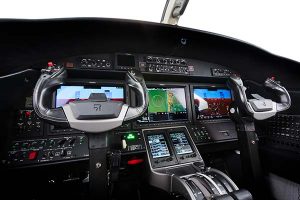
Flying the M2
At full throttle the Williams International FJ44-1AP-21 turbofans each develop 1,965 lbs of thrust. I’ve always enjoyed hand flying Citations and the M2 is no exception. The M2 has the same harmonious control feel as all the other models in the 525 series, providing great feedback while not being overly heavy.
With a direct climb to FL 410 in 24 minutes (using 435 lbs to get there) and a top speed of .70M/404 KTAS at FL330, the airplane offers pilots great operational flexibility. When flying at FL410 and midweight of 9,500 lbs, I usually see a TAS of 380 to 390 KTs and fuel flow of approximately 700 PPH at ISA temperatures. Alternatively, for higher speed but less range, flying at FL330 the M2 will have a TAS of 404 and burn 43 percent more fuel. My personal preference is to fly at FL 390 to FL 410 even though the cost tradeoff between fuel flow and engine/airframe time is not significantly different than cruising at slightly lower altitudes.
During our flight to Colorado Springs (KCOS), the optimal altitude was FL360 for this short hop. At this altitude we cruised comfortably at 402 KTAS/0.71Mach, burning 440 PPH per side. The G3000 makes enroute flight planning easy, including the automatic landing elevation selection for pressurization. Descending to KCOS, we descended and leveled off at FL270 for ATC, where we flew at 370 KTAS with a total fuel flow of 1,000 PPH.
Preparing for the approach is simple: check the ATIS, automatically load the METAR for weather and performance data, activate V speeds, load the approach and chart and you are set. Setting up for landing, I accessed the performance features of the G3000 and at an elevation of 6,187 MSL. At our landing weight of 9,369 lbs, and Vref of 106 KTS, our runway requirement was only 3,277 feet out of 13,501 feet available on Runway 17L. The M2 is easy to hand fly, and I set up the ILS 17L on the G3000 and intercepted the localizer.
Next-Generation G3000
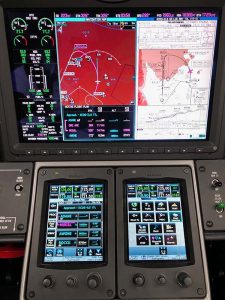
Textron Aviation improved the avionics on its latest production M2s with the upgraded Garmin G3000. Starting with serial number 525-1048 (CJ3+ 525B-0610), they incorporated the latest G3000 hardware and software. This new version of the G3000 features faster processors that allow display of both VFR sectionals and IFR airway charts on the higher resolution (1920 x 1200) displays as well as rapid redraw of the screen images and initialization time of 10 seconds. The concurrent software upgrade includes standard features such as Visual Approaches, ADS-B In, HSI map overlays, standby database capability and European Visual Reference Points (VRPs).
The new G3000 optional features are equally impressive. Sirius/XM weather can now display up to 20 weather products and some can now be animated, a feature I really like to detect trends. To keep up with the latest datacom requirements, FANS-1/A CPLDC, CPLDC FAA Data Comm, SATCOM Direct ACARS, Flightstream 510 and Garmin Connext Position Reporting are optional.
The good news for existing M2 and CJ3+ operators is that many of these software features, Flightstream 510 and Data Comm will be available as upgrades. That upgrade should be available by the end of 2020 or early 2021. The new G3000 displays, supporting higher resolution and VFR/IFR enroute charts, will not be available as a replacement on existing airframes.
Summary
The short flight from Wichita to Colorado Springs was representative of my other experiences flying the Citation M2. The G3000 not only makes the pilot’s job easier, it enhances safety, especially flying in IMC and challenging weather. The smooth handling gives you a feeling of flying a much larger jet, and of course the trailing link landing gear makes landings a breeze. With just slight braking we were quickly off the runway and taxiing to the parking area.
Textron Aviation created a powerful upgrade from the CJ1+, offering owners a unique experience in the Citation 525 series. If you get a chance to fly one, don’t pass it up. You will exit the plane with the same big smile I had following this flight.

Avionics Prove Their Worth
Photo by author.
With three 14-inch displays, of which each can be split, I feel I have full command of my airborne environment. As an example, I recently conducted an M2 training flight for my friend, Brandon Campbell, for his CE525S type rating. We flew around the Midwest and Texas with Hurricane Laura just east of our flight path, causing a large amount of precipitation on our return to Addison airport (KADS) north of Dallas.
It was like flying through a maze. We split Brandon’s PFD to add vertical profile of the GWX 80 Radar, placed Sirius XM weather on the MFD, and selected horizontal mode of the GWX 80 on mine. Using my favorite procedure of using the bearing pointer to determine height and depth of a cell, we were able to navigate between the rapidly building cells with hardly a bump – and no icing.


